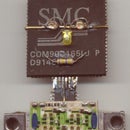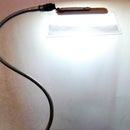Introduction: Twin Jet Paper Airplane
Long ago, before the internet was invented, we used to make these paper airplanes out of paper torn from our notebooks in class. It looks great and flies fast.
The video shows me making and flying the plane.
Step 1: Dismember a Magazine
To keep the tradition alive, I shall build this plane out of scavenged paper - from a magazine.
The first step is to tear off (or cut) a rectangular piece of paper from suitable stock. I am illustrating the process with an old magazine I had lying around.
Step 2: Diagonal Fold
Now fold the paper diagonally as shown in the picture. This forms one fold needed for the plane, and also to mark a square shape.
Step 3: Straight Fold
Now fold the bottom part upwards. This puts a fold exactly where the rectangular piece of paper may be cut to make it into a square one.
The body of the plane is folded from this large square piece.
The smaller rectangular piece becomes the tail.
Step 4: Cut and Separate the Tail
Now open up both folds, and tear off or cut at that straight fold. You will end up with a large square piece, to make the body of the plane, and a smaller, rectangular piece, that makes the tail.
Step 5: Fold Along the Other Diagonal
Now fold the paper along the other diagonal and open it up again. You will have a square piece of paper with folds along the two diagonals.
Step 6: Turn Paper Over
Turn the paper over, so that you are looking at the back of the folds you just made.
Step 7: Parallel Fold
Fold the paper in half, so that the three folds cross each other at the centre of the square. Open it up, again.
Step 8: Magic
It's magic. There is no other explanation, since the paper will automatically fold itself into a sort of triangular hat shape with four leaves at this point.
If it doesn't, (you're a squib?) just take up that piece of paper and urge it to fold along those three lines, all at once.
The two pictures show the paper on my scanner, and the picture taken by the scanner. It is a great way to document instructables, since the scanner automatically takes care of all lighting and framing and exposure.
Step 9: Fold the Fuselage
Now you take the two top 'leaves' and fold them forward, diagonally. This will form the fuselage of the plane.
Step 10: Fold the Engines
The ends of the triangular pieces you have just folded are folded inwards to make the two engines.
Keep them small if you want performace. Or make them large for your plane to have large mean looking engines.
These add drag, so it is preferable to keep them small.
Step 11: Fix the Tail
Now assemble the plane. Take that rectangular piece of paper you did not throw away when you cut it off and insert it into the body of the plane.
Fold the body in half, along the line of the tips of the engines. This fold will also lock the tail in position, and prevent it from taking independent flight when you launch it.
Step 12: Pull Out Engines and Add Dihedral
Now pull those two last fold out so that they look like jet engine nascelles.
Put a dihedral on the wings by folding lengthwise. This also stiffens the tail, and makes the plane stable in flight.
Some control may be excercised over the flight trajectory by warping the wings and tail.
Warp the wings downwards to increase lift. Warp the tail upwards to make the plane climb.
Because of the large weight of the plane in relation to the wing area, this is a fast plane, and flights will be short but fast.
Step 13: Launch It!
That's it, have fun.
The plane is best launched by an overhand throw, nose pointed slightly downward. It shoud swoop close to the ground, then climb because of the initial speed, and then level out and settle gently into a descent.
First Prize in the
Toss It! Speed Contest
Participated in the
The Instructables Book Contest













